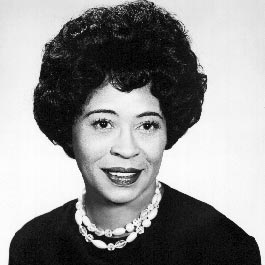
Good morning POU’ers , since this is Black History Month this week’s open thread’s will highlight some new black history facts and people.
Daisy Lee Gatson Bates (November 11, 1914 – November 4, 1999) was an American civil rights activist, publisher, journalist, and lecturer who played a leading role in the Little Rock Integration Crisis of 1957. She grew up in southern Arkansas in the small sawmill town of Huttig. She was raised by the closest friend of her father, who had left the family shortly after her mother’s death. In The Death of my Mother, Bates recounted learning as a child that her birth mother had been murdered by three local white men. Learning of her mother’s death and knowing that nothing was ever done about it fueled her anger.
Daisy’s adoptive father Orlee Smith gave her some last advice while on his death bed.
He said, “You’re filled with hatred. Hate can destroy you, Daisy. Don’t hate white people just because they’re white. If you hate, make it count for something. Hate the humiliations we are living under in the South. Hate the discrimination that eats away at the South. Hate the discrimination that eats away at the soul of every black man and woman. Hate the insults hurled at us by white scum—and then try to do something about it, or your hate won’t spell a thing.”
Bates said she had never forgotten that and it is from this memory that Bates claimed her strength for leadership came. Daisy was 25 when she started dating Lucious Christopher Bates, an insurance salesman who had also worked on newspapers in the South and West. They dated for several months before moving to Little Rock (Pulaski County) in 1941; they were married on March 4, 1942.
Mrs. Daisy Bates immediately joined the local branch of the NAACP upon moving to Little Rock. In an interview she explains her history with the organization and that all her “dreams were tied with this organization”. Her father was a member of the NAACP many years before and she recounts asking him why he joined the organization. She said her father would bring her back literature to read and after learning of their goals she decided to dedicate herself too.
In the same interview when asked what she and the organization were focused on changing, Bates responded “the whole darned system”.However, it was after the Brown v. Board of Education decision that she began to focus mostly on education.
Bates became President of The Arkansas Conference of Branches in 1952 at the age of 38. She remained active and was on the National Board of the NAACP until 1970. Due to her position in NAACP, Bates’ personal life was threatened much of time. In her Autobiography, Bates discussed her life as a president of the NAACP in Arkansas.
“As President of the NAACP State Conference of Branches and as the publicized leader of the integration movement in Arkansas, I was singled out for ‘special treatment.’ Two flaming crosses were burned on our property. The first, a six-foot gasoline-soaked structure, was stuck into our front lawn just after dusk. At the base of the cross was scrawled: “GO BACK TO AFRICA! KKK.” The second cross was placed against the front of our house, lit, and the flames began to catch. Fortunately, the fire was discovered by a neighbor and we extinguished it before any serious damage had been done.”
As the leader of NAACP branch in Arkansas, Bates guided and advised the nine students, known as the Little Rock Nine, when they attempted to enroll in 1957 at Little Rock Central High School, a previously all-white institution.] The students’ attempts to enroll provoked a confrontation with Governor Orval Faubus, who called out the National Guard to prevent their entry. The guard only let the white students to pass the school gate. Eight students out of the nine were asked to go back home. But a student called Elizabeth Eckford who didn’t receive the message from Daisy Bates last night met a mob, when she was trying to find other eight students in that morning. White mobs met at the outside of the school and threatened to kill the black students; these mobs harassed not only activists but also northern journalists who came to cover the story.
Bates used her organizational skills to plan a way for the nine students to get into Central High. She planned for ministers to escort the children into the school, two in front of the children and two behind. She thought that not only would they help protect the children physically but having ministers accompany them would “serve as powerful symbols against the bulwark of segregation.” Bates continued with her task of helping the nine enroll in school. She spoke with their parents several times throughout the day to make sure they knew what was going on. She joined the parent-teacher organization, even though she did not have a student enrolled in school. She was persistent and realized that she needed to dominate the situation in order to succeed.

